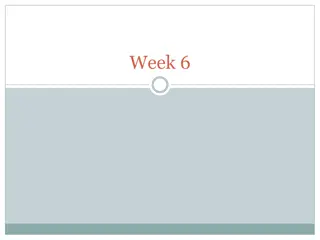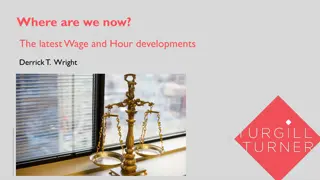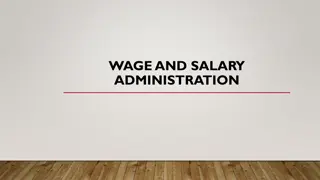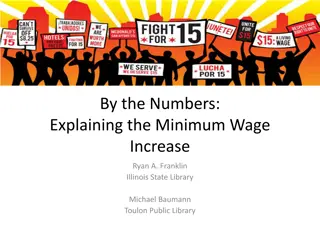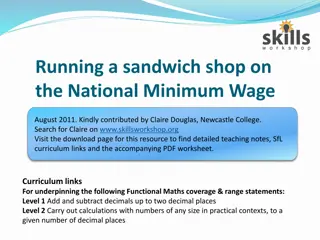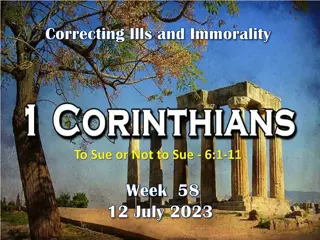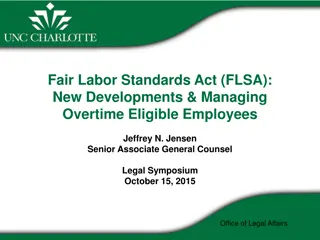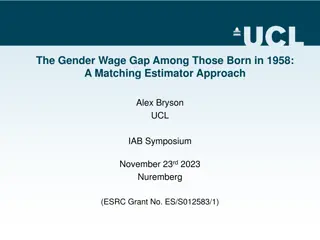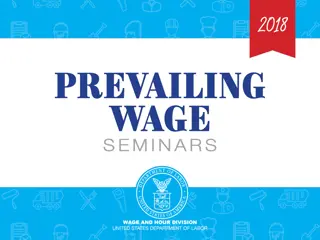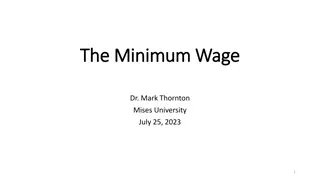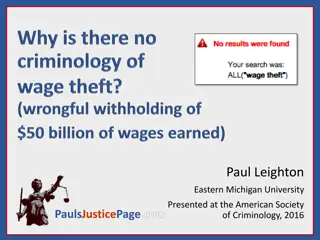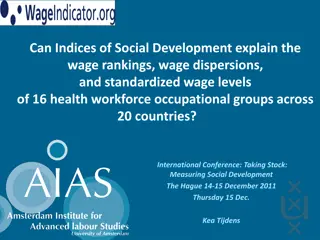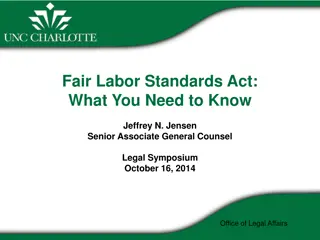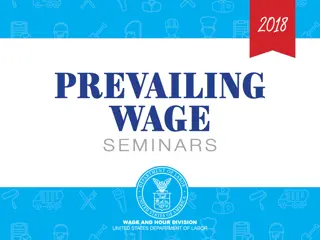Significant Challenges in Wage and Hour Lawsuits
Continued increase in class action wage and hour litigation poses personal liability risks for employers. Recent amendments to New York minimum wage laws and white collar exemptions, along with issues like worker misclassification, create compensation pitfalls for non-exempt employees. The surge in federal wage and hour lawsuits highlights the costly consequences of violations and the potential for owners and officers to face personal liability. A key case example underscores how individuals can be held responsible for wage liability even without direct involvement in day-to-day operations.
Download Presentation

Please find below an Image/Link to download the presentation.
The content on the website is provided AS IS for your information and personal use only. It may not be sold, licensed, or shared on other websites without obtaining consent from the author.If you encounter any issues during the download, it is possible that the publisher has removed the file from their server.
You are allowed to download the files provided on this website for personal or commercial use, subject to the condition that they are used lawfully. All files are the property of their respective owners.
The content on the website is provided AS IS for your information and personal use only. It may not be sold, licensed, or shared on other websites without obtaining consent from the author.
E N D
Presentation Transcript
WAGE AND HOUR UPDATE John M. Godwin, Esq. jgodwin@hodgsonruss.com eporican@hodgsonruss.com 716.848.1357 Emina Poricanin, Esq. 716.848.1336
A Time of Significant Challenges Continued Class Action Wage and Hour Litigation Heightened Personal Liability Risks Increase in New York Minimum Wage Amendments to the White Collar Exemptions Loss of Federal Companionship and Live-In Domestic Exemptions Worker Misclassification New Guidance and Continued Complication Compensation Pitfalls for Non-Exempt Employees
Wage & Hour Lawsuits Continue to Skyrocket
Wage and Hour Lawsuits Plaintiffs attorneys continue to aggressively pursue class action wage and hour claims Year over year, federal wage and hour lawsuits filed in federal courts continue to increase. As of September 2014, wage and hour filings increased from 7,500 to 8,160 per year (almost a 9% increase). The 8,160 figure appears to be an all-time high for FLSA filings. It is the highest annual number registered in more than 20 years, according to statistics that go back to 1993, when 1,457 FLSA cases were commenced.
Wage and Hour Violations are Costly, and Expose Owners and Officers to Personal Liability
Personal Liability as Employer Irizarry v. Catsimatidis (2d Cir. 2013). Catsimatidis was chairman, president, and CEO of Gristede s Foods, Inc. He exercised little, if any, direct day-to-day control over employees, yet the Second Circuit found that he was personally liable to his employees for the company s wage liability. The Second Circuit began its opinion by noting that most circuit courts have held that a company owner, president, or stockholder must have at least some degree of involvement in the way the company interacts with employees to be considered an FLSA employer. According to the Second Circuit, to be an employer, an individual must possess control over a company s actual operations in a manner that relates to a plaintiff s employment. There must be some degree of individual involvement in a company in a manner that affects employment-related factors, such as workplace conditions and operations, personnel, or compensation.
Personal Liability as Employer Irizarry v. Catsimatidis (2d Cir. 2013). The court emphasized that nothing in the FLSA requires an individual to have been personally complicit in FLSA violations before he or she can be held personally liable. Instead, the court noted that an individual could be held personally liable in two ways: (a) through evidence indicating that individual s direct control over the employees; or (b) through evidence showing an individual s authority over management, supervision, and oversight of a company s affairs in general as such is relevant to the individual s operational control of the company s employment of employees. According to the court, a person exercises operational control over employees if his or her role within the company, and the decisions it entails, directly affect the nature or conditions of the employees employment. The court held that operational control need not be exercised constantly to support a finding of personal liability. Control may be restricted, or exercised only occasionally, and still support a finding of personal liability.
Personal Liability as Owner NY Business Corporation Law Section 630 The top ten shareholders of private New York corporations are jointly and severally personally liable for all debts, wages, or salaries due to employees. NY Limited Liability Company Law Section 609(c) Effective February 25, 2015, the top ten members of private New York LLCs are jointly and severally personally liable for all debts, wages, or salaries due to employees. Before an employee can hold a shareholder or member personally liable under either law, he or she must give notice to the shareholder/member within 180 days of the termination of his or her employment.
Potential Wage and Hour Liabilities Fair Labor Standards Act (2 or 3 years if willful ) New York Labor Law (civil complaint) (6 years) New York Labor Law (DOL complaint) (6 years) Back pay Back pay Back pay Liquidated damages equal to 100% of back pay Liquidated damages equal to 100% of back pay Liquidated damages equal to 100% of back pay Fines Pre-judgment interest on the unpaid wages at a 9% annual rate Interest on the unpaid wages at 16% annual rate Willful violations of the FLSA may result in criminal prosecution and the violator fined up to $10,000. A second conviction may result in imprisonment. Employers who fail to pay wages in accordance with the provisions of the Labor Law, and the officers and agents of any corporation who knowingly permit such failure, are guilty of a misdemeanor for the 1st offense and a felony for the 2nd offense Employers who fail to pay wages in accordance with the provisions of the Labor Law, and the officers and agents of any corporation who knowingly permit such failure, are guilty of a misdemeanor for the 1st offense and a felony for the 2nd offense Civil money penalties (CMPs) up to $1,100 for each violation for repeated or willful violations of the FLSA. Attorneys fees, unless the civil action is brought by the NY DOL on behalf of individuals Civil penalty of up to 200% of the unpaid wages if the employer willfully or egregiously fails to pay wages. Attorneys fees or injunctive relief Litigation costs An additional 15% in damages if the employer does not comply with a compliance order within 90 days
The Minimum Wage Continues to Increase, and More Significant Increases Are on the Horizon
Minimum Wage Currently, the minimum wage in New York State is $8.75 per hour. As of December 31, 2015, it will increase to $9.00 per hour. On September 10, 2015, Acting Commissioner of Labor, Mario Musolino, signed an order significantly increasing the minimum wage of fast food employees in fast food establishments in New York State. The wage increase will be phased in as follows: New York City $10.50 on December 31, 2015 $12.00 on December 31, 2016 $13.50 on December 31, 2017, and $15.00 on December 31, 2018 Rest of the New York State $9.75 on December 31, 2015 $10.75 on December 31, 2016 $11.75 on December 31, 2017 $12.75 on December 31, 2018 $13.75 on December 31, 2019 $14.50 on December 31, 2020, and $15.00 on July 1, 2021.
Minimum Wage On the same date, Governor Cuomo announced that he wants to raise New York s minimum wage for all workers to $15 per hour, which would make it the highest in the nation. A statement issued by the Governor s office stated that it will endeavor to build support for a new minimum wage bill in the coming months, and that the bill would be introduced in the next legislative session. Federal contractors and subcontractors: $10.10 per hour beginning January 1, 2015 for employees working on or in connection with covered federal contracts. Beginning January 1, 2016, and annually thereafter, this rate will be determined by the Secretary of Labor. The DOL has already given notice that the rate, beginning January 1, 2016, will increase to $10.15.
United States Department of Labor Proposes Significant Changes to Regulations Governing White Collar Exemptions
Amendments to the White Collar FLSA Exemptions On March 13, 2014, President Obama issued a Presidential Memorandum directing the Secretary of Labor to update the regulations governing the white collar overtime exemptions, and consider how they could be revised to: Update existing protections to be consistent with the intention of the Fair Labor Standards Act. Address the changing nature of the American workplace. Simplify the overtime rules to make them easier for both workers and businesses to understand and apply.
Proposed White Collar Changes On June 30, 2015, the U.S. Department of Labor released its proposed rule that would amend the white collar exemptions. If adopted, the proposed rule would dramatically increase the federal minimum salary level for the executive, administrative, and professional exemptions from $455 per week ($23,660 per year) to a projected $970 per week ($50,440 per year). For New York employers, the current minimum salary level for administrative and executive employees is $656.25 per week ($34,125 per year). The proposed rule would also increase the minimum salary level for the highly compensated employee exemption from $100,000 per year to $122,148 per year.
Proposed White Collar Changes Additionally, the DOL has proposed indexing these minimum salary levels to either wage growth or inflation, and adjusting them annually. Specifically, the DOL is considering indexing the minimum salary level for executive, administrative, professional, and computer employees to the 40th percentile of earnings for full-time salaried workers, and to the 90th percentile for highly compensated employees. Alternatively, the DOL is considering indexing these minimum salary levels to the consumer price index for urban consumers (CPI-U).
Proposed White Collar Changes Interestingly, the proposed rule does not seek to amend the duties tests applicable to the white collar exemptions. Instead, the DOL is seeking public comment on whether the duties tests are working as intended to screen out employees who it does not believe are bona fide exempt employees. The DOL expressed concern that, in some circumstances, the current duties tests allow employees to be classified as exempt where they are performing a disproportionate amount" of nonexempt work.
Status of Proposed White Collar Changes The DOL stated that it would not extend the time for interested parties and stakeholders to file comments, and true to its word, the 60-Day comment period closed on September 4, 2015. The DOL received 247,064 timely comments (an additional 42,856 have been submitted after the deadline, for a total of 289,920). In 2004, the DOL received about 75,000 comments. The DOL is aiming to have these changes become effective first quarter 2016. In 2004, the DOL took 13 months to review the comments its received. The DOL estimates that, as a result of these changes, 4.68 million employees who are currently treated as overtime exempt will, without intervening action by their employers, become eligible for overtime pay in the first year the rule is in effect.
Current White Collar Exemption Rules
Salary Level Federal Minimum Salary Level: Currently, $455 per week for employees to qualify for the administrative, professional, and executive exemptions. New York Minimum Salary Level: Currently, $656.25 per week for employees to qualify for the executive and administrative exemptions. On December 31, 2015, this will increase to $675.00 per week.
Salary Basis Being paid on a salary basis means an employee regularly receives a predetermined amount of compensation each pay period on a weekly, or less frequent, basis. The predetermined amount cannot be reduced because of variations in the quality or quantity of the employee s work. Subject to certain exceptions, an exempt employee must receive the full salary for any week in which the employee performs any work, regardless of the number of days or hours worked.
Salary Basis An employee is not paid on a salary basis if deductions from the predetermined salary are made for absences occasioned by the employer or by the operating requirements of the businesses. If the employee is ready, willing and able to work, deductions may not be made for time when work in not available.
Permissible Deductions An exempt employee s salary may be reduced without losing the exemption for the following reasons: Absences of one or more full days due to: Personal reasons other than sickness or disability; Sickness or disability if the deduction is made in accordance with a bona fide plan, policy, or practice of providing compensation for salary lost due to illness; Unpaid leave days taken before becoming eligible to receive paid leave or after exhausting paid leave entitlements under the benefit plan; or Unpaid disciplinary suspension for violation of written workplace conduct rules. Penalties imposed for infractions of significant safety rules. Deductions to offset amounts employees receive as jury or witness fees, or for military pay. Days/hours not worked during initial and terminal weeks of employment. Days/hours not worked while on unpaid leave under the Family and Medical Leave Act. Deductions from Leave Banks. Full- or partial-day deductions from leave banks, paid time-off plans, and other leave accruals are permitted to be made for any absence, provided such deductions have no impact on the employee s salary.
Impermissible Deductions Deduction for a partial-day absence to attend a parent-teacher conference Deduction of a day of pay because the employer was closed due to inclement weather Deduction of three days of pay because the employee was absent from work for jury duty, rather than merely offsetting any amount received as payment for the jury duty Deduction for a two day absence due to a minor illness when the employer does not provide wage replacement benefits for such absences
Effect of Impermissible Deductions An actual practice of making impermissible deductions from salary will result in the loss of the exemption: During the time period in which improper deductions were made For employees in the same job classifications Working for the same managers responsible for the actual improper deductions Factors considered in determining whether an actual practice exist include: The number of improper deductions, particularly as compared to the number of employee infractions warranting deductions Time period during which improper deductions were made Number and geographic location of affected employees and responsible managers Whether employer has a clearly communicated policy permitting or prohibiting improper deductions
Safe Harbor The exemption will not be lost if the employer: Has a clearly communicated policy prohibiting improper deductions and including a complaint mechanism; Reimburses employees for any improper deductions; and Makes a good faith commitment to comply in the future Unless the employer willfully violates the policy by continuing to make improper deductions after receiving employee complaints
Correcting Common Misconceptions Regarding the Salary Basis Test The following actions generally do not impact an employee s exempt status: Making deductions from exempt employees accrued leave accounts Requiring exempt employees to keep track of and record their hours worked Requiring exempt employees to work a specified schedule Implementing bona fide, across-the-board schedule changes
Administrative Exemption To qualify for the administrative exemption in New York: The employee must be compensated on a salary or fee basis at a rate of not less than $656.25 per week; The employee s primary duty must be the performance of office or non-manual work that is directly related to the management or general business operations of the employer or the employer s customers; and The employee s primary duty must include the exercise of discretion and independent judgment with respect to matters of significance.
Common Issues with the Administrative Exemption An office/administrative employee does not perform work that requires sufficient discretion and independent judgment with respect to matters of significance to be considered an exempt administrative employee. An employer relies on the administrative exemption for an employee who performs production work (i.e., work directly related to the very goods or services that the employer exists to produce and/or sell). See Whalen v. J.P. Morgan Chase (2d Cir. 2009) (holding that bank underwriters were non- exempt as they performed production work).
Professional Exemption To qualify for the professional exemption, The employee must be compensated on a salary or fee basis at a rate note less than $455 per week; and The employee s primary duty must be the performance of work requiring: Advanced knowledge (which is work that is predominantly intellectual in character and includes the consistent exercise of discretion and judgment) in a field of science or learning customarily acquired by a prolonged course of specialized intellectual instruction; or Invention, imagination, originality, or talent in a recognized field of artistic or creative endeavor.
Common Issues with the Professional Exemption Position is not in one of the professions where specialized academic training is a standard prerequisite for entrance into the field. Primary duty involves performance of work that does not require advanced knowledge in a field of science or learning customarily acquired by a prolonged course of specialized instruction The job is learned through on-the-job training and not through prolonged course of specialized instruction
Executive Exemption To qualify for the executive exemption in New York: The employee must be compensated on a salary basis at a rate of not less than $656.25 per week; The employee s primary duty must be management of the enterprise or a customarily recognized department or subdivision thereof; The employee must customarily and regularly direct the work of 2 or more full-time employees (or their equivalents); and The employee must have the authority to hire or fire other employees, or to make suggestions or recommendations that are given particular weight as to the hiring, firing, advancement, promotion, or other change in status of other employees.
Common issues with the Executive Exemption Working supervisors. The question becomes whether the employee s primary duty is management of the enterprise (or a customarily recognized department or subdivision thereof) or the productive work that he or she performs. Two or more employees taking credit for directing the work of the same group of employees. Not ensuring that employees executive supervises work at least 80 hours each week.
Elimination of the Federal Companionship and Live-In Domestic Service Exemptions
Final Rule Eliminating the Companionship & Live-In Domestic Service Exemptions On October 1, 2013, the Department of Labor promulgated a Final Rule that made a number of important changes to the companionship and live-in domestic service exemptions under the FLSA. Most notably, the Final Rule eliminated these exemptions for third-party providers of home care services. As a result of this change, home care agencies that employ home health aides will be required pay overtime at the rate of 1.5 times each aide s regular rate of pay, rather than 1.5 times the minimum wage. The Final Rule does not change the DOL s regulations regarding hours worked by employees during travel time, sleeping, meal periods, and time spent waiting.
Final Rule Litigation In Home Care Association of America v. Weil, a number of home care industry groups challenged the Final Rule. On December 22, 2014, the U.S. District Court for the District of Columbia vacated the third-party provider section of the Final Rule, thereby allowing third party providers to continue to rely upon the companionship and domestic service exemptions. On August 21, 2015, the U.S. Court of Appeals for the D.C. Circuit reversed the District Court s ruling, unanimously upholding the validity of the Rule.
Final Rule Effective Date The Department of Labor has made clear that it will not begin enforcement of the Final Rule until the Court of Appeals issues a mandate (in this case, by default, the mandate should issue 52 days after the Court of Appeals decision). But the Department has now filed an application to expedite the issuance of mandate and simultaneously promised not to enforce to enforce the Final Rule until 30 days thereafter. Meanwhile, the home care industry litigants that challenged the Rule have applied for a stay of the mandate until the Supreme Court decides whether to hear an appeal of the case. What about risks of private litigation?
Final Rule Moving Forward While possible, it is statistically unlikely that the Supreme Court will agree to hear the industry groups appeal. Absent further regulatory, legislative or judicial action, home health agencies must be prepared to pay home health aides overtime at 1.5 times their regular rate of pay (rather than 1.5 times minimum wage).
New US DOL Worker Misclassification Memo On July 15, 2015, David Weil, the Administrator of the U.S. Department of Labor, Wage and Hour Division, issued a highly anticipated Administrator s Interpretation that provides insight into the DOL s current thinking on the question of whether a worker is an employee or independent contractor under the FLSA. The DOL confirmed that it utilizes a broad economic realities test to determine whether workers are employees for wage and hour purposes the common law direction and control test is not applied. According to Administrator Weil, the DOL will continue to work with the IRS and 22 states on this issue in a variety of ways through, for example, information sharing and coordinated enforcement.
New US DOL Worker Misclassification Memo Businesses should expect that the DOL will utilize the economic realities test, as articulated in the Interpretation, when examining whether workers are properly classified. The Interpretation also confirms that the DOL continues to receive numerous complaints from workers alleging misclassification and leaves little doubt as to its view on the merits of such claims by concluding that most workers are employees under the FLSA. Businesses that proactively address worker classification issues can often achieve far better outcomes than those who find themselves defending individual or class claims or under audit.
Other Worker Misclassification Developments The New York Joint Enforcement Task Force on Employee Misclassification identified nearly 26,000 misclassified employees, discovered nearly $316 million in unreported wages and assessed almost $8.8 million in additional unemployment insurance contributions. Since its inception, the Task Force has conducted 290 joint enforcements sweeps, which have uncovered about 10,300 misclassified workers and $52 million in unreported wages. The Task Force is sharing sweep results with the New York Department of Taxation and Finance and the Internal Revenue Service. Also, President Obama s proposed 2016 budget reaffirms the Wage and Hour Division s focus on detecting and penalizing worker misclassification. One of its Key Enforcement Initiatives for 2015 is addressing the fissured workplace, which is another term for independent contractor relationships and other business models that treat workers as non-employees. The WHD will target industries where the fissured workplace is regarded as prevalent (e.g., janitorial, construction, home health care, nursing, staffing, transportation and trucking, security, restaurants, hotel, oil and gas).
The Consequences of Worker Misclassification: Criminal Risks Criminal Risks Can Arise at Both Federal and State Level Federal Criminal Risks Monetary Fine Imprisonment Criminal liability for certain responsible owners, corporate officers, and employees State Criminal Risks Criminal penalties vary from state to state In New York State criminal risks include o Monetary Fines o Imprisonment o Specific penalties provided for in certain industries (e.g., penalties under Construction Industry Fair Play Act) 43
The Consequences of Worker Misclassification: Taxes and Penalties Liability for unpaid taxes Businesses may be liable for a variety of back-taxes due to misclassification including: Income Taxes FICA FUTA State Unemployment Taxes In addition to owing unpaid monies, businesses may also be liable for interest and/or penalties on these taxes 44
The Consequences of Worker Misclassification: Whistleblower Risks IRS Whistleblower Program Applies to claims of tax liabilities over $2 million or against individual taxpayers with incomes exceeding $200,000 Applies to all tax liabilities, whether based on a mistake or a fraud Allows whistleblowers to recover between 15% and 30% of the total amount recovered New York Whistleblower Program Under the False Claims Act Enacted in August 2010 Applied retroactively to claims arising on or after April 1, 2007 Allows whistleblowers and New York State to sue taxpayers and anyone who assisted them for treble damages for knowingly submitting false returns where tax loss exceeds $350,000 and the defendant had income or sales exceeding $1 million in any year Whistleblowers eligible to receive 15% to 30% of the amounts recovered, depending upon whether the Attorney General intervenes in the suit. Statute of Limitations is 10 years 45
The Consequences of Worker Misclassification: Plaintiffs Lawsuits Key wage and hour related risks associated with using independent contractors may, depending upon the circumstances, include liability for: Minimum wage Overtime Miscellaneous Wage Liabilities Call in pay Spread of hours pay Spit shift pay 46
The Consequences Of Worker Misclassification: ERISA/OBAMACARE Risks ERISA Risks Misclassified workers may be entitled to benefits under various employee benefit plans Improper exclusion of employees from participation in a qualified plan may result in an operational failure of the plan Patient Protection and Affordable Care Act ( ObamaCare ) Risks. The employer mandate of ObamaCare generally requires that businesses with 50 or more full-time employees (or their equivalent) make a certain affordable level of health insurance available to full-time employees or face substantial penalties Employers that misclassify employees as independent contractors may face annual penalties 47
Employee Versus Independent Contractor The Legal Tests Overall Observations Different laws use different tests No single factor is dispositive Rarely is an independent contractor s classification certain 48
Employee Versus Independent Contractor The Legal Tests Common Law Direction and Control Test The Common Law Direction and Control Test is used to determine whether a worker is an employee for most tax purposes IRS had adopted a 20 factor test, but has more recently grouped factors into three categories: Behavioral Control Financial Control Relationship of parties Many states agencies across the country apply variants of the common law test. 49
Employee Versus Independent Contractor The Legal Tests IRS 20-factor test Instructions Training Hiring, supervision, and paying assistants Integration Services rendered personally Continuing relationship Set hours of work Full time required Doing work on employer s premises Order or sequence test Oral or written reports Payment by the hour, week, or month Payment of business and/or traveling expenses Furnishing tolls and materials Significant investment Realization of profit or loss Working for more than one firm at a time Making service available to the general public Right to discharge Right to terminate 50



